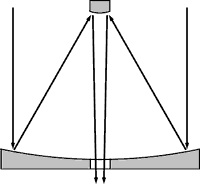Ritchey-Chrétien telescope

A Ritchey-Chrétien telescope is a variation on the Cassegrain telescope in which the primary mirror is a hyperboloid, slightly more strongly figured than the Cassegrainian paraboloid. It is named after its coinventors, the American astronomer George Ritchey (1864–1945) and the French optician Henri Chrétien (1879–1956). Mention should also be made of George H. Lutz, an American astronomer and telescope builder in the 1920s and '30s who was involved with Ritchey in the early stages of design and construction of the Ritchey-Chrétien.
Because Ritchey-Chrétiens are corrected for coma as well as for spherical aberration, they can give relatively sharp images across a wider field of view than do Cassegrains. Good optical performance combined with a short tube length have made this the design of choice for many of the world's largest reflectors, including the Very Large Telescope and the twin 10-meter telescopes at the Keck Observatory.


